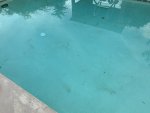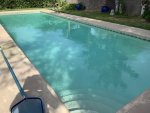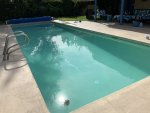Really messed up my pool!
First, my apologies for this long post. it been a heck of a 24 hour period, but I am so glad for all the information and the expert advise I find here.
Welllll... I truly messed up my water! This last couple of years I was using TFP pool care and Maintenence.This year, due to several changes in my schedule, I went back to Pucks and dichlor shock. I know, BAAAAD idea, but there you have it.
I won’t go into all the sordid details, lets just start with where I am now. I was testing every other day or so, and up until last week, everything was Within Defined Limits (WDL) except CYA was low at 10PPM. I added some to a sock and let it run over the return for about 24 hours . This brought it to 30, which In was happy with. We got way more rain than we usually get in New Mexico this season.
I had an algae bloom , Shocked with initially 2 lbs Sodium hypochlorite/dichlor shock, then another 2 lbs and all was good, cleared up.
2 days later, literally right before my eyes, it turned green again. I shocked again with 2 lb -3 lb doses over 2 days, and it just kept getting worse, way green/yellow. Total shock used 21-22 lbs. Still no change in algae. Now I cannot even get a free chlorine or CYA reading on my Taylor DPS K2006 test kit,they are both off the scale. Of course, I came back here and spent all day in the forum reading about my particular problems, learning all about CYA and Over-stabilization, and generally refreshing past lessons learned. As usual, I again have learned a lot.
So here is where I think I am at:
-Finally got a CYA reading using dilution methods posted here, it is extraordinary....wait for it .... CYA= 400-450 !!!!!?
-Best guesstimate on FC is is probably between 35-45. The sample turns pink then quickly bright orange with just 1 scoop of powder, adding more scoops slightly deepens the orange color. I saw a post on this same problem,the solution for that gentleman was to clean everything in the test kit with bleach. This did not work for me. I tried using Drop DPD color comparison method that my kit will also do using dilution, that is how I came up with the guesstimate.
-Cannot truly start a SLAM until I drastically reduce CYA due to the high free chlorine to CYA ratio ,it requires a SLAM FC of 39 or more,which I am probably actually at, but will be hard to maintain.
-My pool is waaaayyy past due for a plaster resurfacing, which I have finally saved up for and I’ll do at the end of this season, so I REALLY don’t want to drain it now, since a full drain is in the near future.
-Today is a very important birthday for my son and of course we planned a pool party, so in desperation, I got some Chlorine Neutralizer, which does not actually list the chemical ingredients ( not sure how the get away with that) but I’m guessing it’s Sodium Sulfite or Thiosulfite. I am using it cautiously, since it is an enemy product and all!?Might be working?
-Pool this morning after multiple brushing’s last night and testing is actually improving,still can’t see the bottom but green is significantly less. I believe this tells me the high chlorine level is actually working on the algae, it is just much slower. Therefore I am now wondering if I should NOT reduce the chlorine to swim level (if that is even possible in the time I have)
SO, this brings me to my questions for you experts, thank you in advance for any thoughts, ideas,or opportunities for fun that may be hiding just under the surface.
Thank you all again for any help or ideas you might have.I apologize for the inordinately long post. I am certainly open to suggestions on streamlining my posts and cutting out unnecessary information .
First, my apologies for this long post. it been a heck of a 24 hour period, but I am so glad for all the information and the expert advise I find here.
Welllll... I truly messed up my water! This last couple of years I was using TFP pool care and Maintenence.This year, due to several changes in my schedule, I went back to Pucks and dichlor shock. I know, BAAAAD idea, but there you have it.
I won’t go into all the sordid details, lets just start with where I am now. I was testing every other day or so, and up until last week, everything was Within Defined Limits (WDL) except CYA was low at 10PPM. I added some to a sock and let it run over the return for about 24 hours . This brought it to 30, which In was happy with. We got way more rain than we usually get in New Mexico this season.
I had an algae bloom , Shocked with initially 2 lbs Sodium hypochlorite/dichlor shock, then another 2 lbs and all was good, cleared up.
2 days later, literally right before my eyes, it turned green again. I shocked again with 2 lb -3 lb doses over 2 days, and it just kept getting worse, way green/yellow. Total shock used 21-22 lbs. Still no change in algae. Now I cannot even get a free chlorine or CYA reading on my Taylor DPS K2006 test kit,they are both off the scale. Of course, I came back here and spent all day in the forum reading about my particular problems, learning all about CYA and Over-stabilization, and generally refreshing past lessons learned. As usual, I again have learned a lot.
So here is where I think I am at:
-Finally got a CYA reading using dilution methods posted here, it is extraordinary....wait for it .... CYA= 400-450 !!!!!?
-Best guesstimate on FC is is probably between 35-45. The sample turns pink then quickly bright orange with just 1 scoop of powder, adding more scoops slightly deepens the orange color. I saw a post on this same problem,the solution for that gentleman was to clean everything in the test kit with bleach. This did not work for me. I tried using Drop DPD color comparison method that my kit will also do using dilution, that is how I came up with the guesstimate.
-Cannot truly start a SLAM until I drastically reduce CYA due to the high free chlorine to CYA ratio ,it requires a SLAM FC of 39 or more,which I am probably actually at, but will be hard to maintain.
-My pool is waaaayyy past due for a plaster resurfacing, which I have finally saved up for and I’ll do at the end of this season, so I REALLY don’t want to drain it now, since a full drain is in the near future.
-Today is a very important birthday for my son and of course we planned a pool party, so in desperation, I got some Chlorine Neutralizer, which does not actually list the chemical ingredients ( not sure how the get away with that) but I’m guessing it’s Sodium Sulfite or Thiosulfite. I am using it cautiously, since it is an enemy product and all!?Might be working?
-Pool this morning after multiple brushing’s last night and testing is actually improving,still can’t see the bottom but green is significantly less. I believe this tells me the high chlorine level is actually working on the algae, it is just much slower. Therefore I am now wondering if I should NOT reduce the chlorine to swim level (if that is even possible in the time I have)
SO, this brings me to my questions for you experts, thank you in advance for any thoughts, ideas,or opportunities for fun that may be hiding just under the surface.
- Since I just need to hold out for the rest of this season, then will do a full drain after resurfacing, but do not want to cause any further damages and will have a difficult time maintaining the high chorine levels, what If I were to convert it to a Bromine pool for the rest of the season? My limited understanding of bromine is that the CYA level is not so critical with a bromine pool?
- Did 22 or so pounds of Sodium Dichlor shock really increase my CYS from 30 to 400 in a few days? There is not a lot of choices for unstabilized chlorine, liquid chlorine is scare in New Mexico. Beware the liquid chlorine from Lowes at a really cheap price, it all seems to be way out of date and my experience was it was very ineffective for its advertised strength. In one of the post, someone said not to use Chlorox? I’m confused, I thought any bleach was fine as long as it had none of the fru-fru’s like scents, etc.
- Any other ideas on the bright Orange color while trying to test Chlorine? I confirmed the reagent were not expired, tested on my city water, which has chlorine, everything worked fine. I didn’t find anything specific to the Orange color at Taylor, and I’m sure we can assume it is something to do it the wacky water “balance” right now or perhaps the Chlorine reducer? I know it is the least of my problems but I’m kinda interested in odd and unusual happenings. According to a post in March 2019 by Joyful Noise, a TFP expert “The DPD indicator should not turn orange. The color a specific dye assumes is based entirely on the molecule itself and it’s atomic structure as well as electron configuration. Orange is very different from the magenta/pink color of the oxidized dye molecule. An orange color would indicate a different absorption happening.”
- Basically, please advise on how I might handle the pool for the rest of the season to minimize damage etc, and what I should do now if you have suggestions or idea’s.It is an old pool but its what I got.
- Lastly, is there a forum to find older model used parts etc I might look at here at TFP?
Thank you all again for any help or ideas you might have.I apologize for the inordinately long post. I am certainly open to suggestions on streamlining my posts and cutting out unnecessary information .





